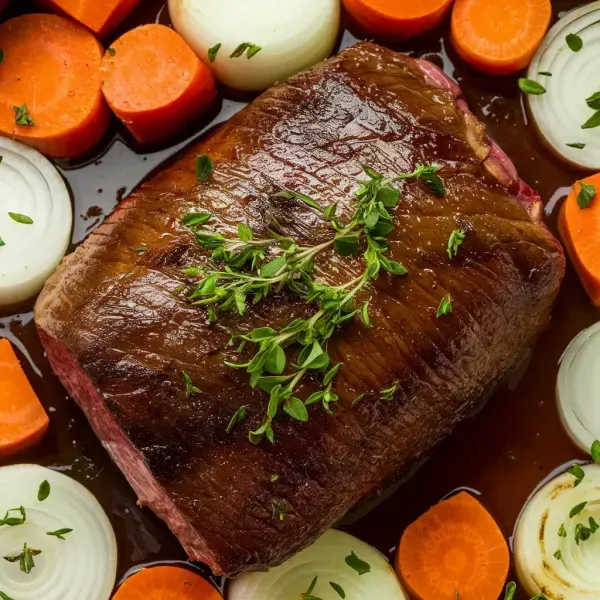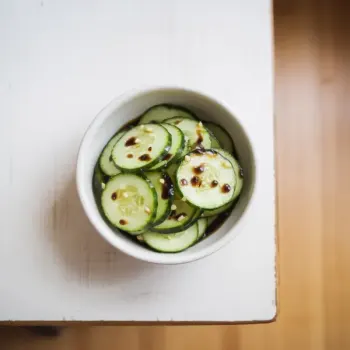
 325 minutes
325 minutesA tender and flavorful beef brisket braised with caramelized onions, carrots, and celery, infused with dry red wine and aromatic herbs.


Whole Beef Brisket
0 lb
to taste
to taste
tablespoons
Yellow Onions, sliced 1/4 inch thick
0 lb
Carrots, cut into large dice
0 lb
Celery, cut into large dice
0 lb
each
cups
Whole Peeled Tomatoes, crushed by hand, with the juices
0 oz
cups
each
each
1. Season Brisket
Begin by seasoning the brisket generously with kosher salt and freshly ground black pepper. This will help to develop the flavor throughout the cooking process.
2. Brown Brisket
If you have a large stainless steel roasting pan, heat the vegetable oil over medium-high heat using two burners. Once the oil is shimmering, brown the brisket on both sides, which should take about 6 minutes per side. The goal here is to achieve a golden-brown crust through the Maillard reaction, which enriches the flavor of the meat.
3. Broil Brisket (Alternative)
If you're using an aluminum roasting pan, preheat your broiler and set the oven rack to the highest position. Place the brisket on a wire rack set over a rimmed baking sheet and broil it for about 6 minutes per side, until a deep brown crust forms.
4. Cook Vegetables
Transfer the brisket to a plate and, in the same pan, add the sliced onions, diced carrots, diced celery, and whole garlic cloves. Season the vegetables with a pinch of salt and cook them over medium-high heat until they begin to brown, which should take about 6 minutes. This step brings out the natural sugars in the vegetables, enhancing their sweetness and complexity.
5. Deglaze with Wine
Pour the dry red wine into the pan, bringing it to a simmer while scraping up any browned bits from the bottom. These bits are packed with flavor and will add depth to your braising liquid.
6. Add Tomatoes and Ketchup
Stir in the hand-crushed tomatoes, along with their juices, and the ketchup. Return the browned brisket to the pan, nestling it among the vegetables.
7. Add Herbs and Braise
Add the thyme sprigs and bay leaves to the pan. Cover the roasting pan tightly with aluminum foil to keep the moisture in, ensuring a tender and juicy brisket.
8. Braise in Oven
Preheat your oven to 300°F (150°C) and place the covered pan in the middle rack. Let the brisket braise for about 3 to 4 hours, or until it is fork-tender. This slow cooking process allows the connective tissues in the brisket to break down, resulting in a melt-in-your-mouth texture.
9. Rest Brisket
Once the brisket is tender, transfer it to a work surface and let it rest for about 30 minutes. This resting period allows the juices to redistribute within the meat, ensuring each slice is juicy and flavorful.
10. Skim Fat and Season Liquid
While the brisket rests, skim any excess fat from the surface of the braising liquid and season it with salt and pepper to taste.
11. Slice Brisket
Slice the brisket thinly against the grain, which helps to keep each slice tender. Submerge the slices back in the braising liquid, cover the pan, and let it stand for another 30 minutes. This final step allows the brisket to absorb even more flavor from the rich, savory liquid.
12. Serve
Serve the brisket warm, surrounded by the caramelized onions, carrots, and celery. Enjoy this hearty and comforting dish with family and friends.
Cook your brisket at 300°F or lower, roughly 1 hour per pound, until fork-tender, allowing the tough connective tissues to break down properly.
Opt for a flat-cut or first-cut brisket which has a consistent thickness and is less fatty. This makes for an evenly cooked, tender result. Select a piece with good marbling for flavor and juiciness.
Allow the brisket to rest for 20-30 minutes before slicing to let the juices redistribute, ensuring a moist and tender result.
Properly caramelize onions for upwards of 30 minutes to unlock their natural sweetness and build a flavorful sauce.
Sear the brisket on all sides in a heavy-bottomed pan before slow cooking to create a savory crust and add depth of flavor.




Comments (0)